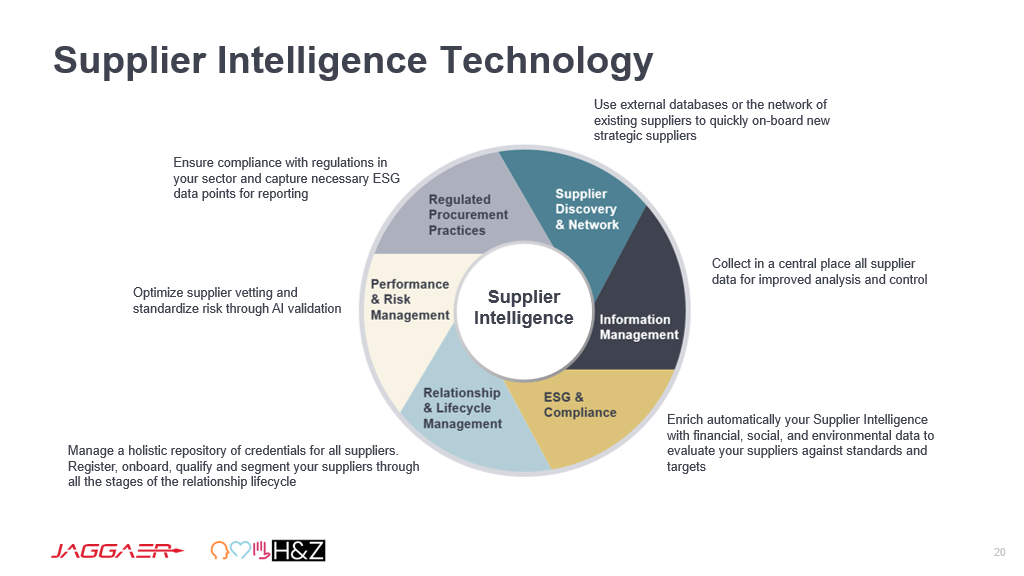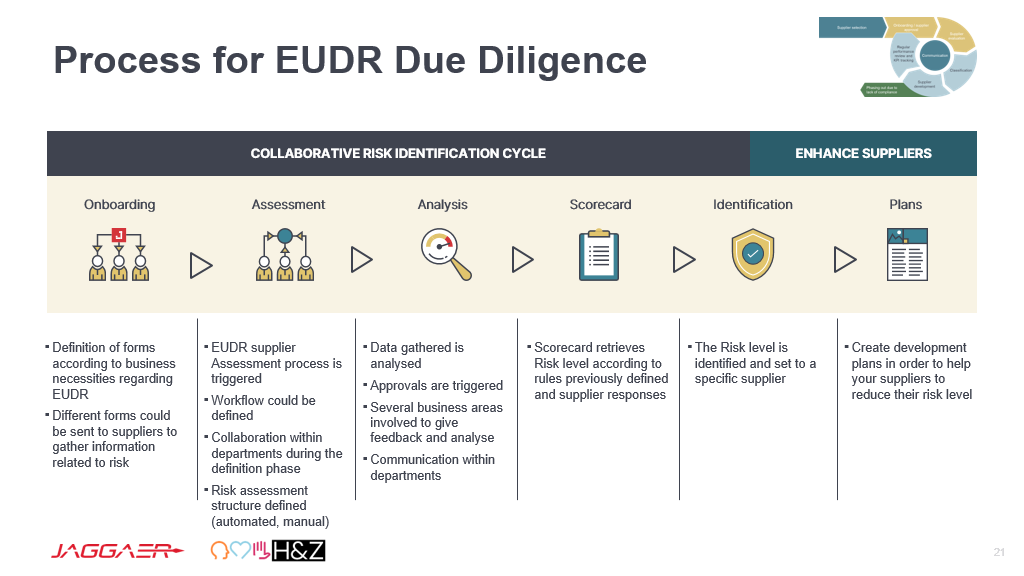As will be clear from the previous article by Robin Schenkewitz of H&Z, the new CSRD, EUDR and CSDDD directives impose significant demands on procurement to collect data about what’s happening in their supply chain. Manual and ad hoc means are no longer up to the task. Supplier intelligence technology is vital for any organization with responsibilities under these directives to become fully compliant, but doing so will also bring business benefits. So, let’s start with an introduction to what it is and how it works.
Supplier Intelligence Technology
Let’s start by considering the capabilities of supplier intelligence technology that can be used to address regulatory issues before we do a deep dive into one use case. (See Figure 1)
These capabilities begin with supplier discovery. JAGGAER uses feeds from external databases together with intelligence in its own network of existing suppliers to enable customers to on-board new strategic suppliers that are either already compliant with the directives or need to be assessed and monitored for risks. Once you’ve done that, you will need comprehensive information management capabilities, including certifications and other documents, all accessible in a central location to support analysis and control. By connecting to external databases, you can then automatically enrich your supplier intelligence with financial, social, and environmental data, enabling you to evaluate your suppliers against standards and targets.
Need deeper insights?
Watch our on-demand webinar to discover practical strategies for managing supply chain sustainability data and compliance.
Supplier intelligence needs constant updating so relationship and lifecycle management is essential to keep track over time. For example, high-risk suppliers can become low-risk suppliers as they change their own sources of supply. And what was once a tactical supplier can become strategic.
Performance management capabilities covering on-time delivery, quality and risk management scorecarding are also part of any modern supplier intelligence platform. Artificial intelligence, for example to cover document validation, is playing an increasingly important role in the standardization and acceleration of performance management. Finally, the supplier intelligence platform will enable you to ensure full compliance with regulations in your sector, capturing the necessary ESG data points for reporting.
Explore how JAGGAER supports supplier compliance workflows.

Above all, to meet the requirements of the various new regulations, the supplier intelligence platform must be flexible. As Robin discussed in his article, there is huge overlap between the various directives, but when it comes down to the details, they all differ in the data requested and the way it is presented. (Robin tells me there may be some harmonization and streamlining through the EU Omnibus regulation, but that remains to be seen.) All this requires different workflows, so the system must be configurable to accommodate not only the needs of the regulator but also your needs as an organization.
There must be a degree of standardization as well as configurability – this will help you to implement the various solutions more rapidly. JAGGAER recently implemented our standard solution for supplier assessments, but we configured specific data collection forms, workflows, risk mitigation plans, different statuses, and a category taxonomy for the various categories impacted by EUDR (these include coffee, cocoa and chocolate, palm oil, soy, rubber, cattle and beef, and wood). (See Figure 2)

Once the data has been collected through forms and workflows it triggers an assessment process in which a risk framework is defined, followed by analysis and approvals, which may involve one or more business areas outside of procurement. A scorecard then retrieves the risk level according to rules previously defined and supplier responses. From this, you can then design a mitigation plan with a list of standard and supplementary actions.
The standard forms and templates we created in this exercise included supplier information, risk information according to Article 10 of EUDR, and a due diligence statement that can be sent out to suppliers, customers and employees as appropriate. Again, it is important to have configurability in these forms – they are not just text fields. You might, for example, want to include alphanumeric fields, date fields, GeoJSON coordinates and so on. With thousands of suppliers, so much data and a lot of variables such as different certifications to check within a specified timeframe, you are probably going to want to leverage artificial intelligence to do the heavy lifting for you. JAGGAER provides this, together with a full audit trail of responses recording any changes over time to give you full transparency.
We designed workflows to ensure that no step in the assessment process is skipped. The first step is sending out a supplier information form, the second is reviewing the results that come back from the supplier, the third is seeking any approvals that may be necessary, followed by further potential steps – if the supplier is high-risk, these would include the mitigation procedures that need to be in place. You can automate the initiation of these workflows, assign step owners to ensure accountability, and embed forms to ensure consistency. Statuses are automatically updated as you progress through the workflow, giving you real-time transparency into the status of every supplier in the system.
Throughout the supplier lifecycle you can then issue forms for completion, track progress, issue reminders, determine next steps and assign statuses, automating before-and-after analysis to see how the situation has changed over time. The scorecarding tool we have implemented in JAGGAER allows you to review and evaluate information provided under Article 9 of EUDR. If necessary, you can score responses, providing a clear fact-based assessment. Weighted responses to questions deliver an overall score, enabling you to decide whether to purchase from a particular supplier.
Once the assessment, analysis and scorecarding have been completed, you can assign a status for each supplier against each category of products, manually or automatically based on the due diligence statement and risk level. This could, for example, involve putting a block on certain suppliers that are identified as non-compliant. It is also possible to set status expiry dates within the system and generate automated expiry alerts. The added benefit of doing this with JAGGAER is that the statuses can be accessed for other procurement processes such as sourcing events.
The next step is to determine any necessary follow up actions, such as a risk mitigation plan with target dates for completion, using templates if desired. You can work collaboratively with suppliers to rectify any issues before re-assessing, for example by documenting the results of site-audits in the system. Moreover, the JAGGAER solution can be integrated with other systems, such as the EU Information System, so you can send across due diligence reports and statements as required.
Finally, all this information is available to you through the JAGGAER data lake via out-of-the-box or custom reporting, giving you a clear overview of all assessments you are running, whether based on specific regulations such as EUDR or at a more general level for internal reporting.
In summary, what you need to do to implement a supplier intelligence solution as described above is first, to define what outputs you will require, get your team together to identify the data points and questions you need to ask, define the process, workflows and governance framework – and then execute!
Ready to transform your supply chain compliance?
Discover how JAGGAER’s supplier intelligence solutions can simplify your sustainability reporting and reduce risk.
Request a demo or Contact our experts to get started today.




